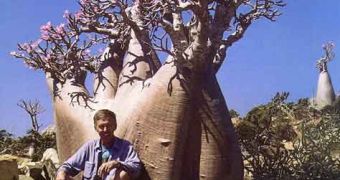In the scorching deserts of southern and eastern Africa and Arabia, where rainfall is a miracle, grows a jewel: the Desert-rose (Adenium obesum), also called Sabi Star or Kudu. It is closely related to the oleander from the Mediterranean area.
With a delicate shape and contorted branches, this evergreen succulent shrub grows slowly up to 1-3 m (3.3 to 10 ft) tall and lives, as it is said, hundreds of years. The cambered stem and roots have the role of a water reservoir, allowing the plant to bloom in a very arid and inhospitable environment.
The latex, roots and milky seeds of this plant contain a deadly poison. Bushmen use the extract made from these seeds for poisoning the tips of their arrows and local fishermen splash branches of this plant into the water so that the fish get dizzy and, thus, be easy to capture.
Moreover, the cattle and camel herders use some parts of the plant for preparing a poison that kills the ticks, lice and other parasites attacking the animals. What is even more surprising is the fact that, despite the deadly toxin, there are wild animals feeding on the plant's leaves, which are spirally arranged, clustered toward the tips of the shoots, entirely simple, leathery in texture, 5-15 cm long and 1-8 cm broad, without being harmed. One of the animals that can eat the poisonous plant is the black rhinoceros.
But why such a deadly plant is called the Desert-rose? That's because of the clusters of delicate flowers, with vivid colors varying between light-pink to dark-red. In the dead desert, dry and dull, this blooming bush is really impressive. The flowers are tubular, 2-5 cm (0.8-2 in) long, with the outer portion 4-6 cm (1.6-2.4 in) diameter with five petals, resembling those of other related plants like the oleander.

 14 DAY TRIAL //
14 DAY TRIAL //